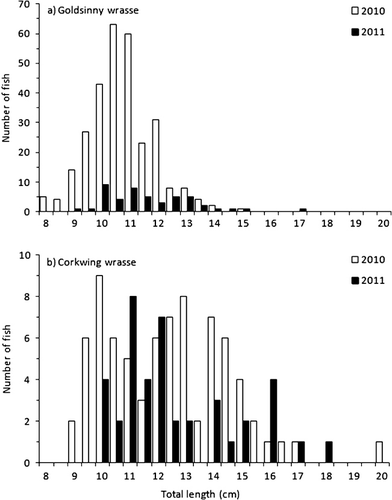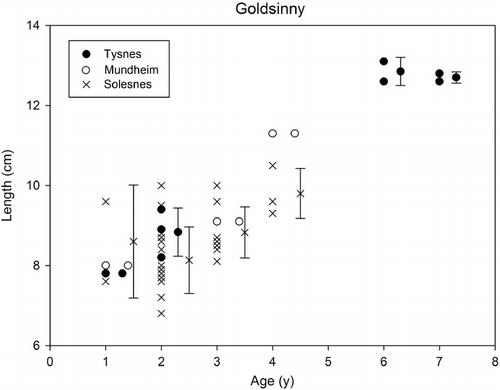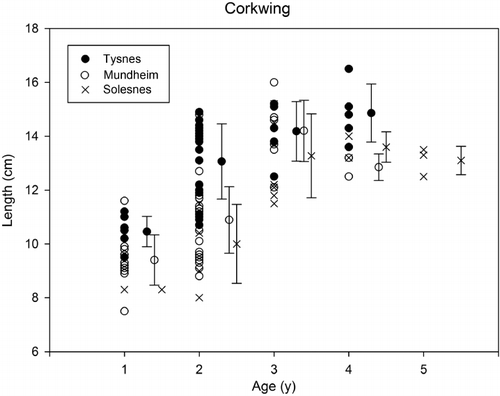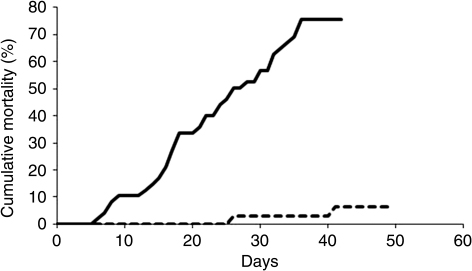Abstract
Several species of wrasse (Labridae) are used as cleaner fish to remove salmon lice from farmed Atlantic salmon. We estimated the fishery and use of wrasse in Hardangerfjord. The estimated numbers of labrids used on salmon and rainbow trout farms varied between 86,000 and 251,000 from 2002–2006, but increased to as much as 1.1 million in 2009 and 2010. A total of 93,500 kg (around 1.54 million) labrids were reported landed during 2000–2010. Corkwing wrasse (Symphodus melops) was by far the most important wrasse species: 52% by weight and 56% by number. Ballan wrasse (Labrus bergylta) made up 34% by weight but only 14% by number (due to its larger size). The relative proportion of species between the different sampling locations in the fjord was significantly different, as was the condition factor of some species. Goldsinny wrasse (Ctenolabrus rupestris) had the slowest growth of the labrids in this study, and did not reach the minimum commercial catch size (11 cm) before they were 4–5 years old. Very few goldsinny caught were over that size. Corkwing reach commercial size in 1–2 years. The results of this study indicate that wrasse should be protected during the spawning season. Species such as goldsinny grow so slowly that they will most likely be collected several times in heavily fished areas but discarded because they are smaller than the minimum allowable size. This could be avoided through the use of modified traps with escape routes for undersized fish. This study represents a first step towards establishing a knowledge-based management plan for the wrasse fishery.
Introduction
Salmon lice (Lepeophtheirus salmonis (Krøyer, 1837)), an ectoparasitic copepod, infestations are a serious problem in salmon aquaculture. The use of wrasse as cleaner fish to remove salmon lice from farmed Atlantic salmon (Salmo salar Linnaeus, 1758) and rainbow trout (Oncorhynchus mykiss Walbaum, 1792) was first tested in laboratory trials in 1988, followed by experiments in net pens (Bjordal Citation1988, Citation1990, Citation1992). The results of those trials were promising, and a commercial fishery for goldsinny wrasse (Ctenolabrus rupestris (Linnaeus, 1758)) started in Norway in 1988, in Scotland one year later, and in England and Ireland in 1990 (Bjordal Citation1991; Darwall et al. Citation1992). Fish farmers have been reporting the use of wrasse to the Norwegian Directorate of Fisheries since the 1990s and they have a time series of the use of wrasse in the production of salmon and rainbow trout, categorized by county, from 1998 to 2010. Although the fishery includes four species of wrasse with different life-history strategies, they have to date been treated as one species, the generic ‘wrasse’. Six species are found in Norway, four of which have been used as cleaner fish for delousing salmonids, namely: goldsinny wrasse (Ctenolabrus rupestris), corkwing wrasse (Symphodus melops (Linnaeus, 1758)), rock cook (Centrolabrus exoletus (Linnaeus, 1758)) and juvenile ballan wrasse (Labrus bergylta Ascanius, 1767). The proportions of the different wrasse species used in Norwegian fish farming are currently unknown.
The use of wrasse on salmon farms in Norway decreased from 1998 to 2005, when effective chemotherapeutics for lice control were developed and applied. In 2007 and 2008 it was reported that salmon lice in several geographic areas had developed resistance to the chemicals used (Nilsen Citation2008). This triggered a renewed interest and an increased demand for cleaner fish. The targeted wrasse fishery increased, and the estimated use of wrasse surpassed 10 million fish in 2010. As a result of the increased demand for wrasse, the fishery in many areas has proved insufficient to meet the demand of local salmon farms. This has resulted in wrasse being transported over long distances by trucks fitted with water tanks or by boats. Millions of wrasse have been transported from the south and southeastern coasts of Norway and Sweden to northern parts of the territory since the early 1990s.
The ecology and life-history characteristics of these wrasse species are practically unknown. A small number of studies have reported maximum ages of wrasse species: 25 years for ballan (Darwall et al. Citation1992), 9 years for rock cook and corkwing wrasse (Darwall et al. Citation1992; Treasurer Citation1994). Sayer at al. (Citation1995) reported a maximum age for male and female goldsinny of 14 and 20 years, respectively, and Darwall et al. (Citation1992) reported cuckoo wrasse of 17 years. Little is known about the life history of the scale-rayed wrasse. The maximum size of the different wrasse species has been reported to be up to 60 cm for ballan wrasse (Quignard & Pras Citation1986), 35 cm for cuckoo wrasse (Darwall et al. Citation1992), 16.5 cm for rock cook wrasse (Sayer et al. Citation1996), 18 cm for goldsinny and 28 cm for corkwing (Darwall et al. Citation1992).
Goldsinny and corkwing wrasse are the most abundant species in Norway. Differences in habitat preferences are poorly documented, but corkwing wrasse is assumed to prefer relatively deeper waters and is the least abundant of the two (Pethon Citation2005). Many wrasse species spawn and forage in territories that are maintained by the dominant males in the population (Sjölander et al. Citation1972; Hilldén Citation1981; Potts Citation1984) and goldsinny males do not leave their territories until their winter migration (Hilldén Citation1981). All of the wrasse used as cleaner fish in Norway occupy shallow waters in the summer and most move to deeper waters in the winter (Sayer et al. Citation1993, Citation1994; Nils Marius Holm, pers. comm.). All of the wrasse species except goldsinny have demersal eggs. Corkwing are typically found in areas of high algal cover, e.g. kelp forests and eel-grass beds (Quignard & Pras Citation1986; Lythgoe & Lythgoe Citation1991), and they are commonly found at depths of less than 5 m (Costello, Citation1991), although they can occur to depths of 15–18 m (Costello Citation1991; Sayer et al. Citation1996). Wrasse species such as goldsinny, corkwing and rock cook are typically found in sheltered or exposed rocky shores, mudflats and kelp forests (Thangstad Citation1999). Wrasse feed on slow-moving or sessile prey.
Goldsinny and corkwing wrasse are the most abundant species in Norway. Differences in habitat preferences are poorly documented, but corkwing wrasse is assumed to prefer relatively deeper waters and is the least abundant of the two (Pethon Citation2005). Many wrasse species spawn and forage in territories that are maintained by the dominant males in the population (Sjölander et al. Citation1972; Hilldén Citation1981; Potts Citation1984) and goldsinny males do not leave their territories until their winter migration (Hilldén Citation1981). All of the wrasse used as cleaner fish in Norway occupy shallow waters in the summer and most move to deeper waters in the winter (Sayer et al. Citation1993, 1994; Nils Marius Holm, pers. comm.). All of the wrasse species except goldsinny have demersal eggs. Corkwing are typically found in areas of high algal cover, e.g. kelp forests and eel-grass beds (Quignard & Pras Citation1986; Lythgoe & Lythgoe Citation1991), and they are commonly found at depths of less than 5 m (Costello, Citation1991), although they can occur to depths of 15–18 m (Costello Citation1991; Sayer et al. Citation1996). Wrasse species such as goldsinny, corkwing and rock cook are typically found in sheltered or exposed rocky shores, mudflats and kelp forests (Thangstad Citation1999). Wrasse feed on slow-moving or sessile prey.
Before 2008, fishermen mainly used fyke nets to collect wrasse, which were traditionally used to catch eel. More recently, pots specifically designed for wrasse have been developed. These pots are now used by the majority of fishermen on the west coast, whereas fyke nets are still in use on the south coast. Unfortunately, bycatch of eel and lobster (which are regulated), as well as other species such as juvenile cod, has been an issue with fyke nets. Reports from fishermen and fish farmers and results from previous studies (Harkestad Citation2011) indicate that wrasse captured during the summer have an increased incidence of wounds and higher mortality, presumably corresponding with their spawning season. Corkwing wrasse is believed to be particularly vulnerable to that effect.
Following from the dramatic increase in fishing pressure on these wrasse – to date an unregulated or lightly regulated fishery – an evaluation of the basic demographics and population responses to the fishery was deemed necessary by the Norwegian officials and the salmon farming industry. In this article, we report biological (e.g. condition, length, age) and catch data from the Hardangerfjord region of Norway, an area in which wrasse are typically subjected to high fishing pressure. We describe the use of wrasse in this region and investigate some possible sources of mortality linked to bycatch and the transport of these fishes. The key questions addressed in this study relate to the sustainability of the wrasse fishery, the seasonality of fishing, wrasse welfare and the impacts (on local populations) of long-distance transport of fish. We also present preliminary data from a mark–recapture study that will serve as a basis for future monitoring of wrasse. The information presented here represents a first step on the road towards establishing a knowledge-based management plan for the wrasse fishery.
Material and methods
Official statistics: catch data and use in salmon farms
Reported landings of labrids in the Hardangerfjord area during 2000–2010 were obtained from the official catch statistics compiled annually by the Norwegian Directorate of Fisheries. Reported landings in gross weight (the entire amount caught, without specifying the number of fish) of labrids were converted to numbers by application of the official Norwegian conversion factors from numbers to gross weight (kg) of different labrid species ().
Table I. Official Norwegian conversion factors used to convert numbers to weight (kg) for different labrid species.
The number of salmon and rainbow trout reported in fish farms located in the Hardangerfjord area were based on the regular monthly biomass reports made to the Norwegian Directorate of Fisheries by salmon farmers during 2002–2010. The official annual statistics of numbers of labrids used by fish farmers are presented by county. However, the exact numbers of wrasse used by fish farmers in the Hardangerfjord area are not known. Thus, in order to estimate the number of labrids used annually by salmon farmers in the area, it was assumed that the annual proportion of labrids to mean salmon biomass (in numbers) on salmon farms in the Hardangerfjord area was the same as in the county of Hordaland where the Hardangerfjord is situated, and was estimated as:
Fyke-net sampling, 2006, 2010–2011
The nets used in this study consisted of two double fyke nets connected to each other. The four collectors (5 hoops each, about 1 m long) and two 3 m long leaders were attached in the following sequence: collector–leader–collector–collector–leader–collector. This allowed us to increase the sampling area. The fyke nets (unbaited) were set from shore at about 1 m down to 10–20 m depth, perpendicular to the beach line. Although the wrasses are active during the day, the fyke nets were set for three days (i.e. over two nights) to allow night active species to be captured. The sampled area is located on the southern coast of the fjord, i.e. from Svåsand (60°18′N, 6°18′E) to Herand (60°22′N, 6°21′E) in 2006 and from Svåsand to Jondal (60°6′N, 6°15′E) in 2010 and 2011. The area from Jondal to Herand is characterized by steep topography and only six sites were suitable for fyke-net sampling. In 2010, several commercial fishermen targeting wrasse were observed at the same sampling locations (Agnalt, pers. comm.). Whenever possible, we set several fyke nets at the same site, at approximately 3 m distance from each other. A total of 30, 34 and 14 fyke nets were sampled at these sites in 2006, 2010 and 2011, respectively. Bad weather conditions in 2011 prevented us from setting fyke nets in some of the more exposed sites, resulting in a lower number of net sets. The sampling period extended over about 1 week during late September and early October each year. Total length was recorded for all wrasses collected. Estimates of number of each species captured per fyke-net haul are presented in order to standardize and compare between years.
Wrasse-specific data and mark–recapture study
In order to collect wrasse for species identification, length measurements, mark–recapture, and age and weight, unbaited fyke nets were used at Mundheim while baited pots were used at Solesnes (60°17′N, 6°16′E) and Tysnes. The sampling was conducted in collaboration with local fishermen using the gear that they use in the wrasse fishery. The pots (or fyke nets) were sampled the day after they were set.
Fish from each pot (or fyke net) were identified to species and total length was measured to the nearest 0.5 cm. Each fish was tagged with a 1–2 mm visible implant elastomer tag (VIE; Northwest Marine Technology Inc.) placed under the skin in front of the pectoral fins, ventrally. The same areas were fished 1–2 weeks later and the percentage of tagged fish in the traps was noted for each of the species.
For aging, samples of fish from one or two traps were euthanized by overdose of anaesthetic and transported to the lab. Fish were identified to species and their total length measured to the nearest 0.5 cm and weighed to the nearest gram. Otoliths were removed for age estimation.
Distribution of wrasse species at each locality was compared using chi-squared tests. Non-parametric Kruskal–Wallis tests were used to compare condition of fish between localities.
Abundance of wrasse species in areas sampled by the fishermen was assessed using the Petersen–Lincoln estimate, which assumes that the ratio of marked individuals (M) to population size (N) is equal to the ratio of marked fish that were recaptured (R) to the catch taken for census (C) (Ricker Citation1975):
Effects of capture and transport
In order to assess the mortality associated with the fishing gear, wrasse captured with one fyke net (Mundheim, 14 June) and one pot (Solesnes, 14 September), with about 70 fish in each, were carefully collected. Each catch was divided into two 50-litre plastic bags containing 25 litres of seawater. The bags were filled with oxygen, closed with plastic strips and transported to the Institute of Marine Research in Bergen, where they were transferred to a 500-litre tank with flow-through seawater at 15°C. The tank was fitted with stacks of PVC pipes as shelter and wrasse were fed daily with frozen krill. Mortality was registered daily.
Results
Estimated use of wrasse in the Hardangerfjord area
The mean annual biomass of farmed salmon in the Hardangerfjord area increased from 9.9 million individuals in 2002 to 25.5 million individuals in 2009. The mean annual biomass of rainbow trout in the Hardangerfjord area increased from 0.33 million to 1.75 million individuals between 2002 and 2010. The estimated number of labrids used on salmon and rainbow trout farms varied from 86,000 to 251,000 in the period 2002–2006, but has since increased to as much as 1.1 million individuals in 2009 and 2010 ().
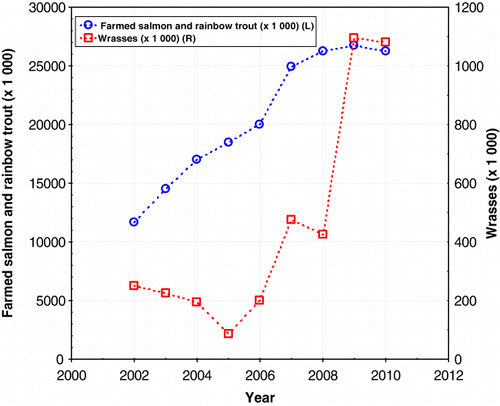
The percentage of labrids-to-salmon on salmon farms was between 1.1% and 2.2% in 2002–2004, dropped to 0.5% in 2005, and increased from 1.0% in 2006 to 4.1% in 2010. A total of 93,500 kg (around 1.54 million) labrids were reported landed during 2000–2010 in the Hardangerfjord area (). The highest landings were reported in the southeastern part of the region. Until 2010, ballan wrasse was the only species with reported landings. However, after 2010, when landings had to be reported by species, corkwing was by far the most important wrasse species, constituting almost 52% in biomass and 56% by number. Ballan wrasse made up 34% in biomass but only 14% by number (due to its larger size).
Table II. Reported landings of different labrid species in total per year in weight (kg) and in estimated numbers, given in parentheses, in the Hardangerfjord area during 2000–2010.
Fyke-net sampling, 2006, 2010–2011
Overall, 26 species were captured each year, independent of location, and on average from 21 to 27 fish were captured per fyke-net haul. Goldsinny dominated the samples in late September 2006, with an average of 15 fish captured per fyke-net haul (). Green crab (Carcinus maenas) ranked as the second most captured species with 1.6 crabs per fyke-net haul. Although some corkwing wrasse were recorded, capture rates were low (1.1 per haul). Goldsinny also dominated samples collected in late September 2010, with an average of about 23 fish captured per haul (). Corkwing ranked as second with 6.2 and ling (Molva molva) as the third most important species with 3.7 fish captured per haul. European lobster (Homarus gammarus) and saithe (Pollachius virens) were captured in relatively high numbers, i.e. 3.7 and 2.9 animals per fyke-net haul, respectively. The following year, in early October 2011, goldsinny had dropped to 5.5 per fyke-net haul, closely followed by corkwing at 4.1 fish per haul (). The dominant species in 2011 was green crab with 8.3 captured per fyke-net haul, but saithe were also captured in relatively high numbers (2.4 fish per haul).
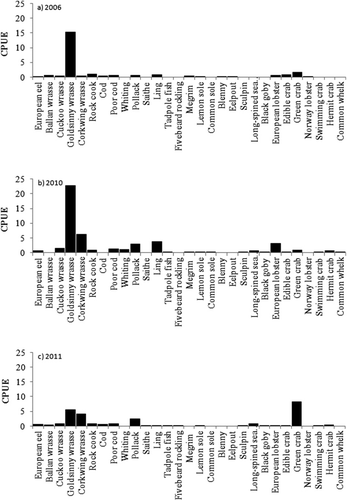
The total length of the goldsinny sampled in 2010 () ranged from 8 to 15 cm, with a peak around 10.5–11 cm. Another peak was identified at around 12 cm in total length. In 2011 (), fewer fish were captured but the length range was similar, from 9 to 17 cm in total length. Peaks were observed at 10, 11 and 12.5–13 cm in total length. A higher percentage of goldsinny wrasse captured in 2011 were above 10 cm in total length compared with 2010. The length of corkwing wrasse captured in 2010 () ranged from 9 to 20 cm in total length, with several peaks (10, 12.5 and 14.5 cm total length). Fewer corkwing wrasse were captured in 2011 (), and they ranged in size from 10 to 18 cm in total length.
Species distribution, condition and age at three locations in 2011
The relative proportion of species was significantly different between the different locations within the Hardangerfjord region (chi-squared test, p<0.001) (). Corkwing wrasse was the dominant species at Mundheim and Tysnes, while goldsinny was dominant at Solesnes. Mundheim was the only locality where rock cook was captured, apart from a few at Solesnes. Ballan wrasse and cuckoo wrasse were captured in very small numbers at all three of these locations.
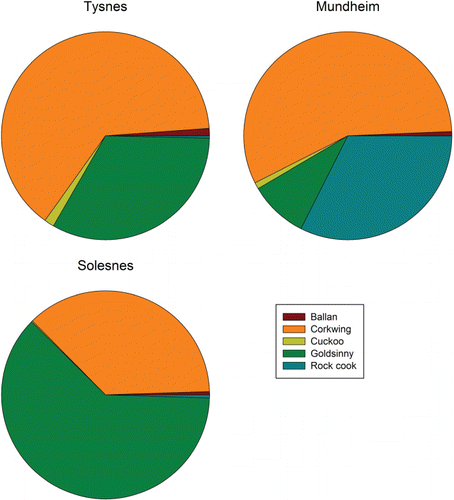
Condition factor was significantly different in corkwing wrasse between the different locations (Kruskal–Wallis test, p<0.001; ). Fish from Mundheim had a significantly lower condition factor than corkwing at Solesnes and Tysnes. Statistical tests could not be carried out for rock cook and goldsinny, because there were not enough individuals at some locations.
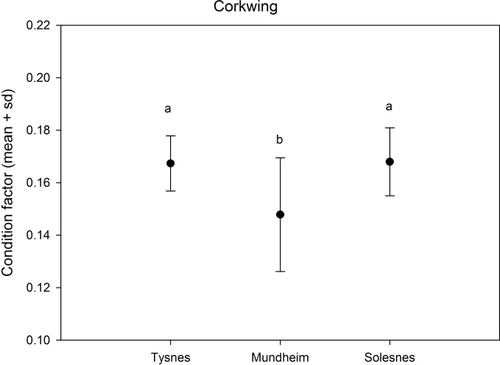
There were significant differences in recapture rate between goldsinny and corkwing except at the two Tysnes locations (). The calculated population size for the most common species caught is given in . Results for fish based on low sample sizes should be viewed as preliminary.
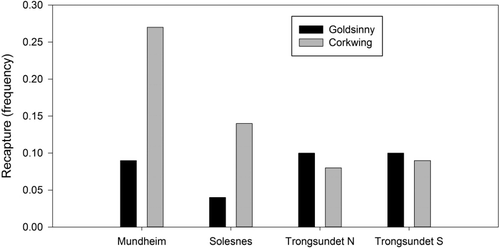
Table III. Sampling locations, mark–recapture results and population size estimates for three species of wrasse.
Goldsinny showed the slowest growth of the wrasse in this study; they did not reach the minimum commercial catch size (11 cm) before they were 4–5 years old (). Very few individuals caught were over that size. Corkwing showed higher growth than goldsinny and reached commercial size within 1–2 years ().
Effects of capture and transport
Cumulative mortalities in the two groups of captured fish kept in tanks were calculated. In the batch caught on 14 June, mortality reached 75% 35 days after capture (). In the batch caught on 14 September, only 3 fish (5%) died during a captivity period of 48 days ().
Discussion
All catches of labrids in the Hardangerfjord area during 2000–2009 were reported as ballan wrasse, which was obviously inaccurate. Catches of labrids, both in terms of biomass and number, were low compared to the numbers of wrasse used by salmon farmers (see and ). Catches of labrids were underreported during this period, especially before 2006. At that time, wrasses were to a large extent sold privately to fish farmers and not officially registered. From 2006, the fisheries sales organizations in Norway obtained a monopoly on the sale of labrid catches, and all catches sold through the fisheries sales organizations were officially registered. However, it was only in 2010 that the catches of labrids appear to be more reliably reported, in terms of numbers and species composition. Indeed, for 2010 we found a high consistency between both reports: for the number of wrasse caught in the fishery and the number of wrasse used by salmon farmers in the area. This indicates that the salmon farmers probably used mostly locally caught wrasses that year.
Before 2010, the reported number of individuals from each species was probably incorrect. First, converting kg to numbers may not give the correct number of fish, because the frequency distribution of fish size varies in space and time and the species identifications made by the fishermen are often incorrect so that the wrong conversions could have been used. In addition, there is an unregistered and, therefore, unknown mortality due to discarding of wounded and dead fish during catch operations, intermediate storage, transport and delivery. The actual catches of wrasse were, therefore, most likely higher than the numbers reported as used on salmon farms.
Despite the extensive local wrasse fishery, wrasse were also imported to Hardangerfjord from other areas, mainly from the southern Norwegian coast. However, the number of wrasse imported from other areas is unknown, as is the genetic structure of the stocks. Since wrasse species are particularly stationary (Espeland et al. Citation2010), it is likely that local populations are genetically isolated and transport operations will, therefore, affect stock structure. Genetic analyses of the various wrasse species and populations are scarce, especially for the time period before the wrasse fishery began. Sundt & Jørstad (Citation1993, Citation1998) reported allozyme analyses of goldsinny and found significant genetic differences between locations, including differences between inner fjord samples and coastal samples. Sundt & Jørstad (Citation1998) also found significant differences in a goldsinny sample caught in southern Norway (Arendal), transferred to mid-Norway, and compared with local wrasse. Information and knowledge of the genetic population structure of the different wrasse stocks that are currently under heavy exploitation are needed to evaluate potential effects of, for example, transfer between regions and possible mixing and inter-breeding with local populations. Import of wrasse may also result in transfer of wrasse pathogens, although to date no information about this has been reported.
Wrasse are among the most common and numerous fishes found in shallow coastal areas, from southern Norway to Trondheimsfjord (Thangstad Citation1999; Gjøsæter Citation2002). This was also the case for at least the central part of Hardangerfjord in 2006 and in 2010. However, in 2011 considerably fewer wrasse were captured. Whether this decrease is due to overfishing is difficult to conclude from only one year of data. In a nearby fjord, Bjørnafjord, investigations that have taken place since the early 1990s show a similar strong decline in the wrasse populations, specifically in 2011 (Agnalt, unpubl. data). It is important to establish a routine sampling programme to clarify whether fishing has had an important impact on the wrasse populations.
Even if wrasses are among the most common fish in the southern part of Norway, the importance of these fishes as part of the dynamics in complex coastal ecosystems in these areas is unclear. They forage mostly on slow moving or sessile prey (Fjøsne & Gjøsæter Citation1996; Sayer et al. Citation1996; Thangstad Citation1999) and are most active during the warmest part of the year.
Goldsinny and corkwing males forage inside territories. Territory size is usually less than 2 m2 for goldsinny and around 10 m2 for corkwing (Sjölander et al. Citation1972; Hilldén Citation1981). The females that are associated with the males often also feed inside the same territory. We observed that species composition of wrasse varied between areas. Our observations show that species composition could vary between sites located approximately 30 km from one another (Mundheim, Solesnes and Tysnes). It is difficult to generalize about the size and species composition of wrasse in an entire fjord or region when the populations vary significantly over short distances.
The wrasse species that are currently used on salmon farms all exhibit a high level of site fidelity (Espeland et al. Citation2010; Skiftesvik, unpubl. data). Therefore, when fish above a certain size are removed by fishing, the size structure of the population will be an indicator of fishing intensity (Shepherd et al. Citation2010). Lewin et al. (Citation2006) reported that fishing which selectively exploits larger fish is the major factor in reducing female mean size. In the wrasse fishery, the larger specimens in the population are the ones being removed. A small proportion of the goldsinny from our catches were over 11 cm, the minimum commercial catch size for wrasse (). If wrasse populations are indeed genetically isolated, then there could be a strong selection for smaller size and slower growing fish in areas with heavy fishing.
Fishing will most likely affect the populations of wrasse differently since their life histories are so different. We found that goldsinny grew slower than corkwing and can have a lifespan of more than 20 years (Sayer et al. Citation1995), whereas the faster growing corkwing wrasse () has a life expectancy of 9 years (Darwall et al. Citation1992); therefore, goldsinny will be more sensitive to heavy fishing.
There is considerable loss of wrasses in the salmon net pens due to predation, handling, escapes and disease. The ratio between these factors is not known. Corkwing wrasse appears to be particularly vulnerable to bacterial infections, leading to high mortalities after release in the net pens. Several opportunistic and pathogenic Vibrio spp. have been identified in dying corkwing wrasse in captivity (Jensen et al. Citation2003; Bergh & Samuelsen Citation2007; Harkestad Citation2011). The highest mortality rate has been recorded in fish caught during the spawning season (Harkestad Citation2011). This has also been reported by fishermen, as well as fish farmers. A high mortality rate results in a continuous demand for fish, which drives the fishery. In order to improve the sustainability of the fishery, these sources of mortality should be reduced. The survival rate of wrasses kept in tanks in June (during the spawning season) was considerably lower than the survival rate in September, when spawning was over. This makes it clear that wrasse should be protected during the spawning season. Doing so would prevent high mortality in species sensitive to handling while they are spawning (e.g. corkwing) and would also allow spawners to make their contributions to recruitment before they are removed from the population. Goldsinny grow so slowly that they will likely be collected several times in heavily fished areas but discarded because they are below minimum size. This could be avoided through the use of modified traps with escape routes for undersized fish.
The information presented here represents a first step on the road towards establishing a knowledge-based management plan for the wrasse fishery. Still lacking is additional information about the life histories of these wrasse, at what age they enter the reproductive population, the effect of introducing genetically distinct individuals from distant locations, and assessing what proportion of the demographic changes observed (size and age) are natural vs. driven by the intense size-selective fishery. This can only be achieved if a routine sampling programme is established wherever wrasse are being fished.
Editorial responsibility: Kathrine Michalsen
Acknowledgements
This research was supported by the Norwegian Directorate of Fisheries, the Norwegian Seafood Research Fund (Project # 900609 to ABS) and the Norwegian Institute of Marine Research.
References
- Bergh Ø, Samuelsen OB. 2007. Susceptibility of corkwing wrasse Symphodus melops, goldsinny wrasse Ctenolabrus rupestris, and Atlantic salmon Salmo salar smolt, to experimental challenge with Vibrio tapetis and Vibrio splendidus isolated from corkwing wrasse. Aquaculture International 15:11–18. 10.1007/s10499-006-9061-2
- Bjordal Å. 1988. Cleaning symbiosis between wrasse (Labridae) and lice infested salmon (Salmo salar) in mariculture. International Council for the Exploration of the Sea, Mariculture Committee 188/F 17. 8 pages.
- Bjordal Å. 1990. Sea lice infestation on farmed salmon: Possible use of cleaner-fish as an alternative method for de-lousing. Canadian Technical Report of Fisheries and Aquatic Sciences 1761:85–89.
- Bjordal Å. 1991. Wrasse as cleaner-fish for farmed salmon. Progress in Underwater Science 16:17–28.
- Bjordal Å. 1992. Cleaning symbiosis as an alternative to chemical control of sea lice infestation of Atlantic salmon. I: The importance of feeding behaviour for the efficient culture of salmonid fishes. In: Thorpe JE, Huntingford FA, editors. World Aquaculture Workshops, No 4. Baton Rouge, FL: World Aquaculture Society, p 53–60.
- Costello MJ. 1991. Review of the biology of wrasse (Labridae: Pisces) in northern Europe. Progess in Underwater Science 16:29–51.
- Darwall WRT, Costello MJ, Donnelly R, Lysaght S. 1992. Implications of life-history strategies for a new wrasse fishery. Journal of Fish Biology 41(Supplement B):111–23. 10.1111/j.1095-8649.1992.tb03873.x
- Espeland SH, Nedreaas K, Mortensen S, Skiftesvik AB, Agnalt A-L, Durif C, et al. . 2010. Kunnskapsstatus leppefisk – utfordringer i et økende fiskeri. Fisken og Havet 7/2010. 35 pages.
- Fjøsne K, Gjøsæter J. 1996. Dietary composition and the potential of food competition between 0-group cod (Gadus morhua L.) and some other fish species in the littoral zone. ICES Journal of Marine Science 53:757–70. 10.1006/jmsc.1996.0097
- Gjøsæter J. 2002. Distribution and density of goldsinny wrasse (Ctenolabris rupestris) (Labridae) in the Risør and Arendal areas along the Norwegian Skagerrak coast. Sarsia 87:75–82. 10.1080/003648202753631758
- Harkestad LS. 2011. Eksperimentell smitte av grønngylt, Symphodus melops, med V. tapetis-isolatene CECT 4600, LP2 og NRP45. MSc Thesis. Institutt for biologi, Universitetet i Bergen. 136 pages. (in Norwegian)
- Hilldén N-O. 1981. Territoriality and reproductive behaviour in goldsinny, Ctenolabrus rupestris (L.) (Pisces, Labridae). Behavioural Processes 6:207–21. 10.1016/0376-6357(81)90001-2
- Jensen S, Samuelsen OB, Andersen K, Torkildsen L, Lambert C, Choquet G, et al. . 2003. Characterization of strains of Vibrio splendidus and Vibrio tapetis isolated from corkwing wrasse (Symphodus melops) suffering vibriosis. Diseases of Aquatic Organisms 53:25–31. 10.3354/dao053025
- Lewin W-C, Arlinghaus R, Mehner T. 2006. Documented and potential biological impacts of recreational fishing: Insights for management and conservation. Reviews in Fisheries Science 14:305–67. 10.1080/10641260600886455
- Lythgoe JN, Lythgoe GI. 1991. Fishes of the Sea: The North Atlantic and Mediterranean. London: Blasford Press. 256 pages.
- Nilsen F. 2008. Påvisning av Emamectinresistente lakselus i Noreg. Norsk Fiskeoppdrett 6:58–60. ( in Norwegian)
- Pethon P 2005. Aschehougs Store Fiskebok, 5th edition. Oslo: Aschehoug. 468 pages.
- Potts GW. 1984. Parental behaviour in temperate marine teleosts with special reference to the development of nest structures. In: Potts GW, Wootton RJ, editors. Fish Reproduction: Strategies and Tactics. London: Academic Press, p 223–44.
- Potts GW. 1985. The nest structure of the corkwing wrasse, Crenilabrus melops (Labridae: Teleostei). Journal of the Marine Biological Association of the United Kingdom 65:531–46. 10.1017/S002531540005058X
- Quignard J-P, Pras A. 1986. Labridae. In: Whitehead PJP, Bauchor M-L, Hureau J-C, Nielsen J, Tortonese E, editors. Fishes of the North-eastern Atlantic and the Mediterranean. Volume II. Paris: UNESCO, p 919–42.
- Ricker WE. 1975. Computation and interpretation of biological statistics of fish populations. Bulletin of the Fisheries Research Board of Canada 191. 382 pages.
- Sayer MDJ, Gibson RN, Atkinson RJA. 1993. Distribution and density of populations of goldsinny wrasse (Ctenolabrus rupestris) on the west coast of Scotland. Journal of Fish Biology 43(Supplement A):157–67. 10.1111/j.1095-8649.1993.tb01185.x
- Sayer MDJ, Cameron KS, Wilkinson G. 1994. Fish species found in the rocky sublittoral during winter months as revealed by the underwater application of the anaesthetic quinaldine. Journal of Fish Biology 44:351–53. 10.1111/j.1095-8649.1994.tb01212.x
- Sayer MDJ, Gibson RN, Atkinson RJA. 1995. Growth, diet and condition of goldsinny on the west coast of Scotland. Journal of Fish Biology 46:317–40. 10.1111/j.1095-8649.1995.tb05972.x
- Sayer MDJ, Gibson RN, Atkinson RJA. 1996. Seasonal, sexual and geographical variation in the biology of goldsinny, corkwing and rock cook on the west coast of Scotland. In: Sayer MDJ, Treasurer JW, Costello MJ, editors. Wrasse: Biology and Use in Aquaculture. Oxford: Blackwell Science, p 13–46.
- Shepherd SA, Brook JB, Xiao Y. 2010. Environmental and fishing effects on the abundance, size and sex ratio of the blue-throated wrasse, Notolabrus tetricus, on South Australian costal reefs. Fisheries Management and Ecology 17:209–20. 10.1111/j.1365-2400.2009.00697.x
- Sjölander S, Larsson HO, Engström J. 1972. On the reproductive behaviour of two labrid fishes, the ballan wrasse (Labrus bergylta) and Jago's goldsinny (Ctenolabrus rupestris). Revue du Comportement Animal 6:43–51.
- Sundt R, Jørstad KE. 1993. Population genetic structure of wrasse used as cleanerfish in Atlantic salmon farming in Norway. ICES, CM 1993/G:30. 11 pages.
- Sundt R, Jørstad KE. 1998. Genetic population structure of goldsinny wrasse, Ctenolabrus rupestris (L.), in Norway: Implications for future management of parasite cleaners in the salmon farming industry. Fisheries Management and Ecology 5:291–302. 10.1046/j.1365-2400.1998.540291.x
- Thangstad T. 1999. Spatial and temporal distribution of three wrasse species (Pisces: Labridae) in Masfjord, western Norway: Habitat association and effects of environmental variables. MSc Thesis. University of Bergen, Norway. 116 pages.
- Treasurer JW. 1994. The distribution, age and growth of wrasse (Labridae) in inshore waters of west Scotland. Journal of Fish Biology 44:905–18.

